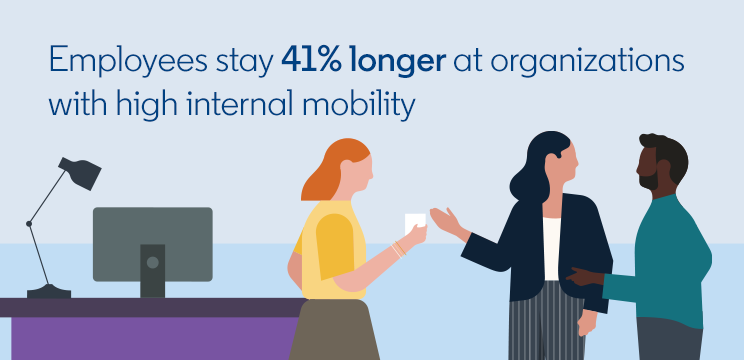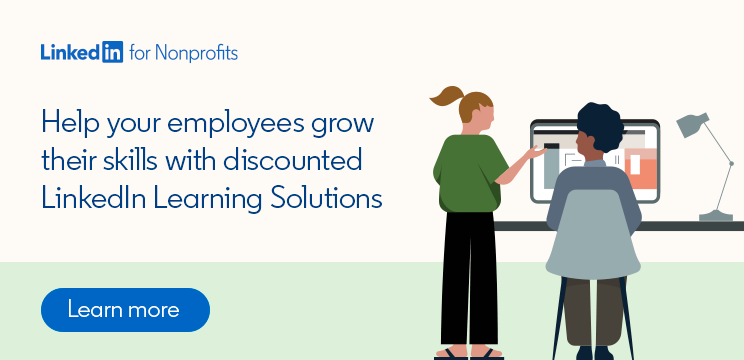
How to Boost Nonprofit Employee Retention in Three Steps
According to the 2023 Workplace Learning Report, 93% of organizations are very concerned about employee retention. This may be an especially critical pain point for nonprofits, as the most recent Nonprofit Talent Retention Practices Survey from Nonprofit HR found that 80% of nonprofits do not have a talent retention strategy in place.
Even organizations that are taking active steps to boost employee retention sometimes have trouble connecting these efforts to what their employees really want. LinkedIn research shows that 94% of employees report they would stay at a company longer if they were offered more learning opportunities — and 74% want time to learn during work, and employees consistently rank “opportunities to learn and grow” as the number one driver of positive work culture.
But while 78% of U.S. nonprofits said they were prioritizing learning and development to encourage retention in 2022, only 40% of young nonprofit professionals surveyed by AFP Global agree their organization offers any form of career advancement assistance. And according to the Workplace Learning Report, which compiles data from global professionals across countless industries:
Only 15% say their organization encouraged them to move to a new role
Only 26% say their organization challenged them to learn a new skill
Only 14% say their organization encouraged them to build a new career development plan
Ready to give your retention strategy an upgrade? Here are three steps nonprofits can take to boost employee retention by supporting employees’ professional development.
Step 1: Create career paths tailored to each employee’s professional goals
Among workers who left nonprofit jobs in 2021, 44% said they left because the organization didn’t offer enough opportunities for career growth or professional development. That’s why it’s essential to not only understand your employees’ career goals, but also outline steps they can take to achieve them.
Working collaboratively with team members to develop tailored career paths won’t just benefit retention. Globally, employees report that making progress toward their own career goals is their top motivation for learning at work. When employees are engaged in learning, they’re more likely to be engaged in their work — and they’re developing the skills to future-proof your organization.
Step 2: Connect career paths to opportunities for internal mobility
Developing unique career paths shows employees that your nonprofit is invested in their future. From there, you can reinforce this commitment and earn their loyalty by clearly communicating about opportunities for internal mobility — both laterally and vertically.
This is important, because 38% of young nonprofit professionals think they’ll need to move organizations in order to earn a promotion. What’s more, two-thirds (66%) think they’ll need to leave their current organization in order to improve their leadership skills for fundraising, and 58% believe they’ll have to switch employees if they want to improve their skills in managing a team.
Clear communication can help to curb these doubts. Encourage managers to have regular conversations with team members about what they need to do to achieve their next promotion. If an employee is interested in a role outside of their current team, consider offering a rotation to let them try it on for size, then put their name forward for any long-term opportunities that open up.

This is also a great way to keep high-performing talent within your nonprofit. Employees stay an average of 41% longer at organizations with strong internal mobility programs. After two years at an organization, employees who have made an internal move have a 75% chance of staying with their employer. Those who haven’t only have a 56% chance.
Step 3: Encourage mentorship across the organization
As they grow and shape their careers, employees want their managers and senior leaders to be involved Studies show that employees who feel like their manager understands and supports their career goals are 2.3x more likely to be engaged, 2.3x more likely to have clarity about their company’s strategy, and 2x more likely to stay at the organization.
Offering formal or informal mentorship opportunities can help employees find the support and guidance they need to thrive at your nonprofit. In fact, 81% of nonprofit professionals say they’ve met co-workers they’d consider a professional role model already. By encouraging and fostering relationships like these, you can create a connective workplace where employees will want to stay and learn together.
Even if you don’t have a formal mentorship program, ensure managers have the tools they need to effectively mentor team members and help them develop their skills. This could include access to learning resources like on-demand courses that managers can recommend whenever they identify a gap in their direct reports’ knowledge or an opportunity for growth.
Empower employees to grow their careers with LinkedIn Learning
Providing timely, personalized learning opportunities is one of the best ways to help employees develop as professionals — and envision their future at your organization.
LinkedIn Learning can help you offer your nonprofit employees the kind of opportunities they’ll be excited about. With LinkedIn Learning, managers can recommend expert-led courses, build customized Learning Paths, and track employees’ progress. Team members can also explore courses they’re interested in, learning at their own pace and at the time that’s most convenient for them.
To learn more about LinkedIn Learning Solutions for nonprofits, get in touch with our team.

